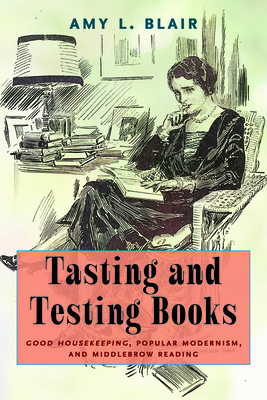You are here
Back to topTasting and Testing Books: Good Housekeeping, Popular Modernism, and Middlebrow Reading (Studies in Print Culture and the History of the Book) (Paperback)

Description
In its February 1926 issue, Good Housekeeping magazine introduced a column for its approximately one million subscribers called “Tasting and Testing Books.” The column’s author, Emily Newell Blair, would go on to produce ninety-one reading advice columns for the magazine between 1926 and 1934. During this period, Good Housekeeping became the most widely circulated periodical in the United States, doubling its circulation to over two million copies. Much of its popularity stemmed from its intensive promotion of its Seal of Approval for a variety of products, which brought consumers to it for utilitarian purposes. With her focus on regular books, Blair distinguished herself from highbrow literary critics, many of whom have been objects of study as High Modernists. She offered advice to help middle-class women readers make their own choices about the best books in which to invest time and money, rather than dictating what they should or should not read. She aligns herself with the average subscriber, outside the book publishing and reviewer industries, focusing on books that would now be termed middlebrow reading.
Blair’s time at Good Housekeeping covers the era from the heights of the “Roaring Twenties” to the depths of the Great Depression, and her recommendations offer a window into the uses of middlebrow reading during this period of dramatic economic and social shifts. Tasting and Testing Books argues that the consumer-first message of Good Housekeeping infused Blair’s advice column and validated a new attitude of proudly middlebrow pleasure reading in the mid-twentieth century. These columns shed new light on the reading lives of too-often overlooked women, often living outside of urban centers and away from elite literary circles, and present Emily Newell Blair, who strongly identified with her readers as a truly democratic tastemaker.
About the Author
Amy Blair is associate professor of English at Marquette University and author of Reading Up: Middle-class Readers and the Culture of Success in the Early Twentieth-Century United States. She is also coeditor of the journal Reception: Texts, Readers, Audiences, History.
Praise For…
“I read this book with great pleasure, finding Blair’s approach to this Good Housekeeping columnist and her columns informative and impressive. This recovery project is poised to make a valuable contribution to studies of early- and mid-twentieth century US fiction and literary culture.”—Gordon Hutner, author of What America Read: Taste, Class, and the Novel, 1920—1960
“Blair sets up some fascinating questions about how books were selected and valued in this moment of change. Her sources range from archival—periodicals, letters, and contexts in Emily Newell Blair’s time—to contemporary feminist, cultural-historical, modernist and reception theories. After reading this book, I am left to wonder, with the author, how such a fascinating and important ‘influencer’ has been lost to our literary-historical records.”—Cecilia Konchar Farr, author of Reading Oprah: How Oprah’s Book Club Changed the Way America Reads
